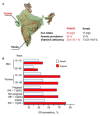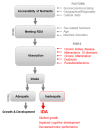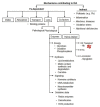Iron Deficiency Anemia: Efficacy and Limitations of Nutritional and Comprehensive Mitigation Strategies
- PMID: 35889932
- PMCID: PMC9315959
- DOI: 10.3390/nu14142976
Iron Deficiency Anemia: Efficacy and Limitations of Nutritional and Comprehensive Mitigation Strategies
Abstract
Iron deficiency anemia (IDA) has reached epidemic proportions in developing countries and has become a major global public health problem, affecting mainly 0-5-year-old children and young women of childbearing age, especially during pregnancy. Iron deficiency can lead to life-threatening loss of red blood cells, muscle function, and energy production. Therefore, the pathogenic features associated with IDA are weakness and impaired growth, motor, and cognitive performance. IDA affects the well-being of the young generation and the economic advancement of developing countries, such as India. The imbalance between iron intake/absorption/storage and iron utilization/loss culminates into IDA. However, numerous strategic programs aimed to increase iron intake have shown that improvement of iron intake alone has not been sufficient to mitigate IDA. Emerging critical risk factors for IDA include a composition of cultural diets, infections, genetics, inflammatory conditions, metabolic diseases, dysbiosis, and socioeconomic parameters. In this review, we discuss numerous IDA mitigation programs in India and their limitations. The new multifactorial mechanism of IDA pathogenesis opens perspectives for the improvement of mitigation programs and relief of IDA in India and worldwide.
Keywords: C-reactive protein; RDA; ferritin; iron deficiency anemia.
Conflict of interest statement
The authors declare no conflict of interest.
Figures




References
-
- Peña-Rosas J. Haemoglobin Concentrations for the Diagnosis of Anaemia and Assessment of Severity. Vitamin and Mineral Nutrition Information System. 2011. [(accessed on 25 April 2022)]. Available online: https://apps.who.int/iris/bitstream/handle/10665/85839/WHO_NMH_NHD_MNM_1....
Publication types
MeSH terms
Substances
LinkOut - more resources
Full Text Sources
Other Literature Sources
Medical
Research Materials

